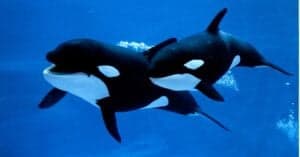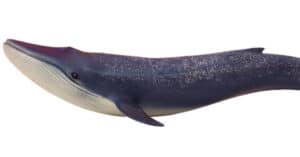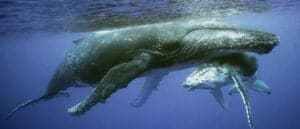Blue Whale Lifespan: How Long Do Blue Whales Live?
@media (min-width: 481px) {
.mobile-top-content {
display: none;
}
}
#mobileTopContentCTACarouselControls { overflow: hidden; text-overflow: ellipsis; white-space: nowrap; }
.mobile-top-content .more { color: #fff; }
.mobile-top-content a { color: #fff; text-decoration: underline; }
.mobile-top-content a:hover { color: #fff; text-decoration: underline; }
@media (max-width: 480px) {
.mobile-top-content {
background-color: #06a10b;
color: #fff;
text-align: center;
/*height: 60px;
padding-top:5px;*/
font-size:80%;
/* display: block; */
margin: 0px -30px;
}
}
Picture the biggest animal that you’ve ever seen on dry land. It’s probably an elephant or a rhinoceros. While these two are the largest animals on land, they’re nothing compared to the sheer enormity of the blue whale. The blue whale, Balaenoptera musculus, is the biggest mammal ever known to have existed on the planet. Dinosaurs are included in this.
Even at birth, blue whales are bigger than adults from most other animal species. The planet is teeming with wonderful and interesting species, but the blue whale is in a class by itself.
Let’s learn everything about this beautiful species, including the blue whale lifespan and more.
Quick Crash Course On Blue Whales
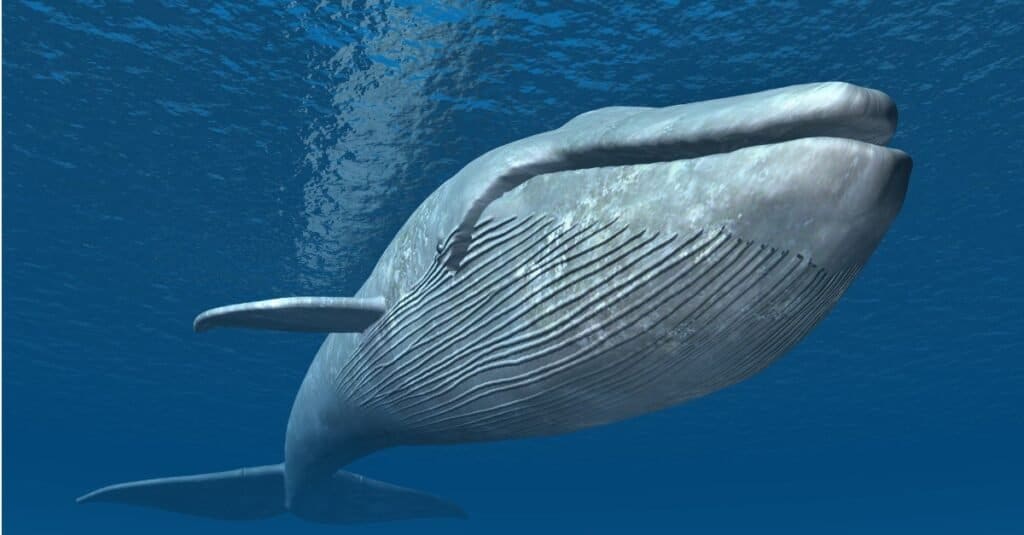
iStock.com/MR1805
Blue whales are very large animals, with average lengths ranging from 80 to 100 feet (24 to 30 meters). In fact, the longest one ever recorded was 108 feet (33 meters). These animals belong to the order Artiodactyla and the family Balaenopteridae, the biggest group of baleen whales that includes the humpback whale.
These majestic creatures weigh between 200,000 and 300,000 pounds (90,000 and 136,000 kilos), or 100 and 150 tons. To truly understand just how large they are, in comparison, an adult African bush elephant may weigh up to 6 tons. In other words, it would take 30 elephants to equal the weight of one blue whale.
Along with being the largest animals, blue whales also make the loudest sounds on the planet. The only issue is that our human ears can’t pick up on it. Underwater, the human ear cannot detect these sounds, but the blue whale makes the loudest noise of any animal, up to 188 decibels. For comparison purposes, this happens to be louder than a jet engine.
Let’s take a closer look at the blue whale lifespan now that we have a deeper knowledge of how incredible these massive whales are.
How Long Do Blue Whales Live?
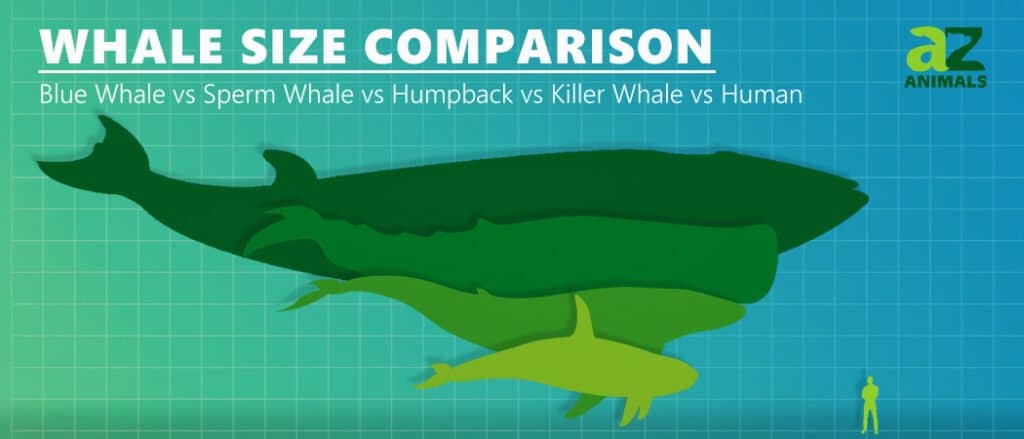
A-Z-Animals.com
The blue whale’s average lifespan is 80-90 years in the wild. Blue whales are among the world’s most long-lived mammals.
Earplugs are the most reliable way to determine the age of blue whales. Throughout their lifetimes, blue whales create earwax (cerumen), which forms lengthy, multilayered plugs. Each deposited light and dark layer (lamina) represents a transition from fasting to eating during migration. The number of layers is a measure of age since one set is put down every year.
Layers in baleen plates were employed prior to the earplug aging procedure. However, these wear down over time and are not as trustworthy. There is also a permanent record in the ovaries of the blue whale when it comes to the number of ovulations, known as corpora albicantia, which was previously used to determine the age.
The Average Blue Whale Life Cycle
A blue whale’s life cycle is divided into three parts. The initial stage is followed by the adolescent and adult stages. Let’s explore these in more detail!
Baby Whale
Every two to three years, female blue whales give birth. During the summer foraging season, pregnant females acquire around 4% of their body weight every day, totaling 60% of their total body weight. Gestation can last 10–12 months, with calves weighing 2–3 metric tons at birth.
The newborns are around six to seven and a half meters long and rely on their mothers for survival at first. Blue whale calves are breastfed by their moms for seven to eight months after birth. They may consume up to 22 to 90 kg of milk per day.
Adolescent
Calves spend up to three years with their mother. They are in the adolescent (juvenile) stage from the time they are weaned until they achieve sexual maturity. Once weaned, juvenile whales begin to socialize with whales of their age and gender. This is the time they begin looking for partners.
Male young whales establish bachelor pods and depart from their original pod. They start looking for sexually mature cows, or female whales, to mate with. Female juveniles begin to venture outside their pod as well, although they are more likely to return to their mother.
Adulthood
In general, blue whales reach adulthood between the ages of 6 and 13 years old. This is the stage at which they are ready to reproduce. They normally move towards the equator to breed. Blue whales have a complex mating ritual. The male and female spend some time rolling about each other before taking a deep dive into the ocean abyss while still communicating with each other. Thus, the life cycle of the blue whale continues.
Factors That Impact The Blue Whale Lifespan
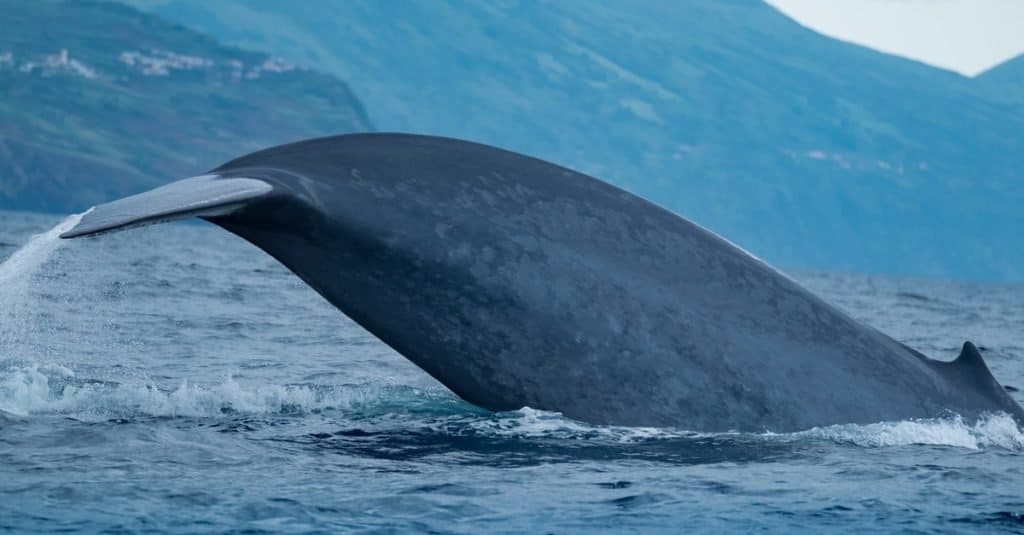
Wild_and_free_naturephoto/Shutterstock.com
Since blue whales are the largest animals on the planet, they have almost no predators to worry about. A pod of killer whales is the only known predator that has attempted to attack a blue whale. However, that doesn’t mean that blue whales don’t have other threats to worry about. Blue whales are listed as endangered under the Endangered Species Act of the United States. They are also listed as endangered and important under the Marine Mammal Protection Act.
Some factors that threaten the blue whale lifespan include:
- Running into boats and other large vessels: Blue whales can be injured or killed as a result of vessel impacts. Vessel impacts have killed blue whales all across their habitat. The danger is substantially higher in coastal locations with considerable vessel activity, such as ports and shipping lanes, as well as from bigger boats and vessels going at fast speeds.
- Getting caught in fishing gear: Blue whales can often become caught in fishing gear. This causes them to either swim away with the gear or become trapped. Blue whales may also become entangled in various types of gear, including traps, pots, and nets. Once caught, they may drag the linked equipment for long distances, resulting in weariness, diminished eating capacity, or serious damage, which may lead to decreased reproductive success and mortality.
- Destruction of their habitat: Other hazards to blue whales include ocean noise, habitat deterioration, ocean pollution, vessel disturbance, and long-term climatic changes. That is why global warming is such a major problem. Destruction of their habitat not only harms them, but also harms many of the animals that they survive on for food.
More from A-Z Animals
.more-snake-card-image { max-height:140px !important; }
@media (min-width: 481px) {
.mobile-top-content {
display: none;
}
}
#mobileTopContentCTACarouselControls { overflow: hidden; text-overflow: ellipsis; white-space: nowrap; }
.mobile-top-content .more { color: #fff; }
.mobile-top-content a { color: #fff; text-decoration: underline; }
.mobile-top-content a:hover { color: #fff; text-decoration: underline; }
@media (max-width: 480px) {
.mobile-top-content {
background-color: #06a10b;
color: #fff;
text-align: center;
/*height: 60px;
padding-top:5px;*/
font-size:80%;
/* display: block; */
margin: 0px -30px;
}
}
Picture the biggest animal that you’ve ever seen on dry land. It’s probably an elephant or a rhinoceros. While these two are the largest animals on land, they’re nothing compared to the sheer enormity of the blue whale. The blue whale, Balaenoptera musculus, is the biggest mammal ever known to have existed on the planet. Dinosaurs are included in this.
Even at birth, blue whales are bigger than adults from most other animal species. The planet is teeming with wonderful and interesting species, but the blue whale is in a class by itself.
Let’s learn everything about this beautiful species, including the blue whale lifespan and more.
Quick Crash Course On Blue Whales

iStock.com/MR1805
Blue whales are very large animals, with average lengths ranging from 80 to 100 feet (24 to 30 meters). In fact, the longest one ever recorded was 108 feet (33 meters). These animals belong to the order Artiodactyla and the family Balaenopteridae, the biggest group of baleen whales that includes the humpback whale.
These majestic creatures weigh between 200,000 and 300,000 pounds (90,000 and 136,000 kilos), or 100 and 150 tons. To truly understand just how large they are, in comparison, an adult African bush elephant may weigh up to 6 tons. In other words, it would take 30 elephants to equal the weight of one blue whale.
Along with being the largest animals, blue whales also make the loudest sounds on the planet. The only issue is that our human ears can’t pick up on it. Underwater, the human ear cannot detect these sounds, but the blue whale makes the loudest noise of any animal, up to 188 decibels. For comparison purposes, this happens to be louder than a jet engine.
Let’s take a closer look at the blue whale lifespan now that we have a deeper knowledge of how incredible these massive whales are.
How Long Do Blue Whales Live?

A-Z-Animals.com
The blue whale’s average lifespan is 80-90 years in the wild. Blue whales are among the world’s most long-lived mammals.
Earplugs are the most reliable way to determine the age of blue whales. Throughout their lifetimes, blue whales create earwax (cerumen), which forms lengthy, multilayered plugs. Each deposited light and dark layer (lamina) represents a transition from fasting to eating during migration. The number of layers is a measure of age since one set is put down every year.
Layers in baleen plates were employed prior to the earplug aging procedure. However, these wear down over time and are not as trustworthy. There is also a permanent record in the ovaries of the blue whale when it comes to the number of ovulations, known as corpora albicantia, which was previously used to determine the age.
The Average Blue Whale Life Cycle
A blue whale’s life cycle is divided into three parts. The initial stage is followed by the adolescent and adult stages. Let’s explore these in more detail!
Baby Whale
Every two to three years, female blue whales give birth. During the summer foraging season, pregnant females acquire around 4% of their body weight every day, totaling 60% of their total body weight. Gestation can last 10–12 months, with calves weighing 2–3 metric tons at birth.
The newborns are around six to seven and a half meters long and rely on their mothers for survival at first. Blue whale calves are breastfed by their moms for seven to eight months after birth. They may consume up to 22 to 90 kg of milk per day.
Adolescent
Calves spend up to three years with their mother. They are in the adolescent (juvenile) stage from the time they are weaned until they achieve sexual maturity. Once weaned, juvenile whales begin to socialize with whales of their age and gender. This is the time they begin looking for partners.
Male young whales establish bachelor pods and depart from their original pod. They start looking for sexually mature cows, or female whales, to mate with. Female juveniles begin to venture outside their pod as well, although they are more likely to return to their mother.
Adulthood
In general, blue whales reach adulthood between the ages of 6 and 13 years old. This is the stage at which they are ready to reproduce. They normally move towards the equator to breed. Blue whales have a complex mating ritual. The male and female spend some time rolling about each other before taking a deep dive into the ocean abyss while still communicating with each other. Thus, the life cycle of the blue whale continues.
Factors That Impact The Blue Whale Lifespan

Wild_and_free_naturephoto/Shutterstock.com
Since blue whales are the largest animals on the planet, they have almost no predators to worry about. A pod of killer whales is the only known predator that has attempted to attack a blue whale. However, that doesn’t mean that blue whales don’t have other threats to worry about. Blue whales are listed as endangered under the Endangered Species Act of the United States. They are also listed as endangered and important under the Marine Mammal Protection Act.
Some factors that threaten the blue whale lifespan include:
- Running into boats and other large vessels: Blue whales can be injured or killed as a result of vessel impacts. Vessel impacts have killed blue whales all across their habitat. The danger is substantially higher in coastal locations with considerable vessel activity, such as ports and shipping lanes, as well as from bigger boats and vessels going at fast speeds.
- Getting caught in fishing gear: Blue whales can often become caught in fishing gear. This causes them to either swim away with the gear or become trapped. Blue whales may also become entangled in various types of gear, including traps, pots, and nets. Once caught, they may drag the linked equipment for long distances, resulting in weariness, diminished eating capacity, or serious damage, which may lead to decreased reproductive success and mortality.
- Destruction of their habitat: Other hazards to blue whales include ocean noise, habitat deterioration, ocean pollution, vessel disturbance, and long-term climatic changes. That is why global warming is such a major problem. Destruction of their habitat not only harms them, but also harms many of the animals that they survive on for food.


